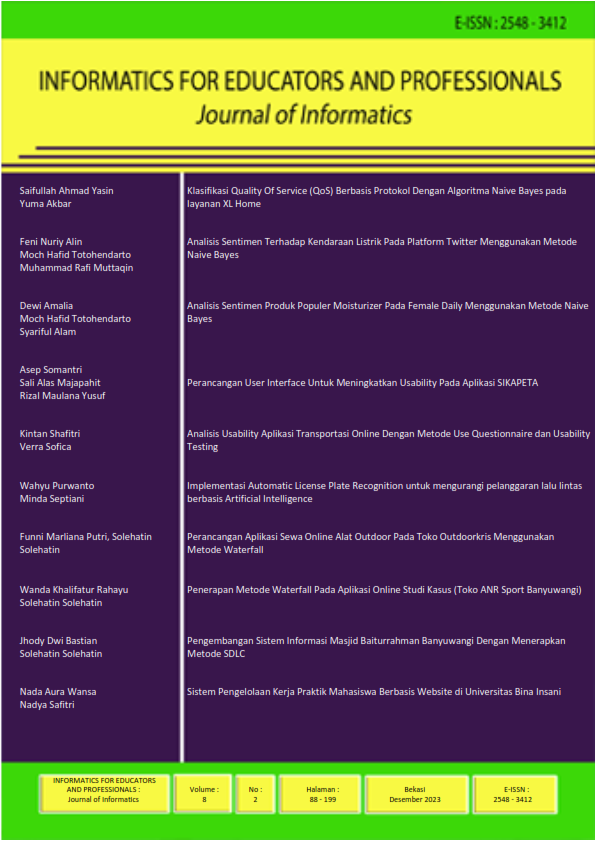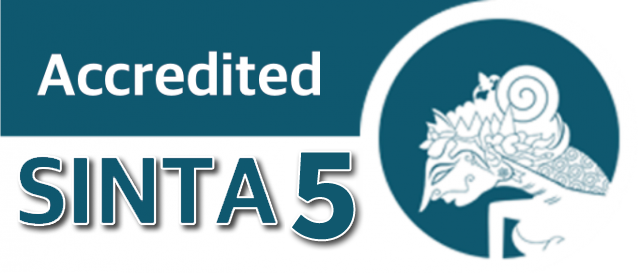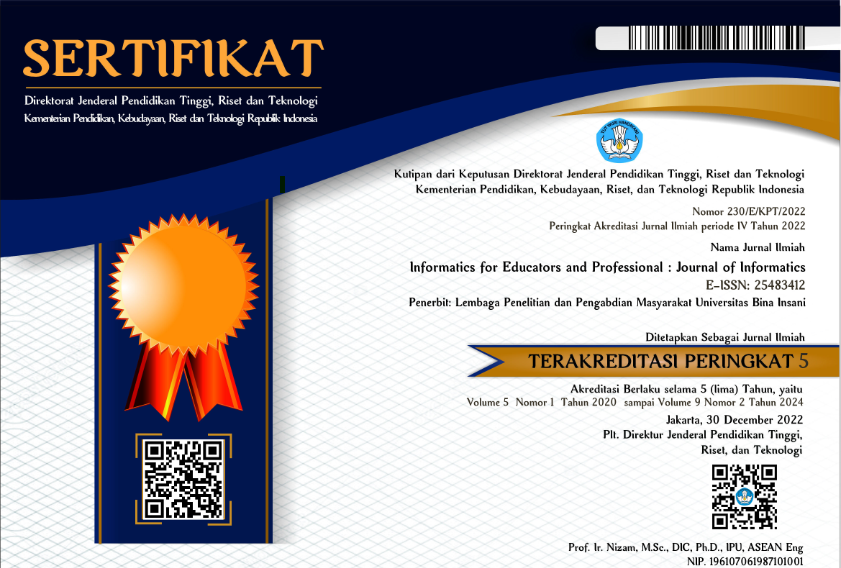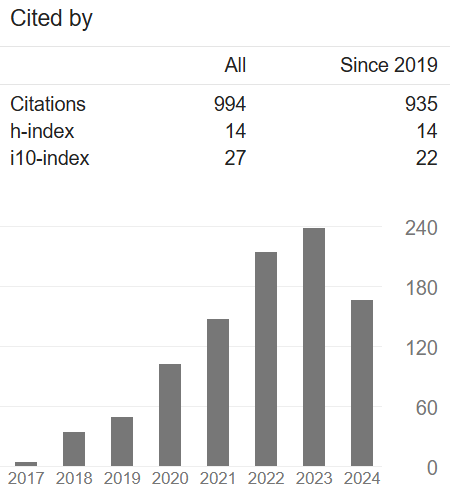Analisis Uji Komparasi Customer Satisfaction Survey Dalam Penggunaan Google Cloud Platform (GCP) Menggunakan Metode Pieces Dan System Usability Scale
Abstract
Cloud Computing technology makes a technology that is most often applied later in the future. Currently, cloud computing technology provides many types of services, including cost management services, data analysis, big data, storage, machine learning, big data, AI, IoT, and application development. Cloud computing technology has made a service and solution, both to increase reliability, reduce computing costs, to provide a great opportunity for the ICT industry to benefit more from cloud computing technology. Customer satisfaction is a level of feeling from someone after being able to compare the performance or results that are felt and obtained compared to their expectations or can be interpreted as a response to customer feedback in using cloud computing technology and an assessment of the good and bad of cloud computing technology which can be used as a reference or a benchmark for cloud computing developers to improve the performance of cloud computing technology that has been built. The level of customer satisfaction can be found using many model methods. In this study the level of satisfaction will be analyzed using the PIECES method and the System Usability Scale. In this study, researchers used two model methods and then carried out a comparative test of these methods. The PIECES variables are Performance, Information and data, Economics, Control and security, Efficiency and Service. The results of the study obtained an average value for each domain, namely the Performance domain with a value of 4.40 (Very Satisfied), Information and data with a value of 4.30 (Very Satisfied), Economics with a value of 4.33 (Very Satisfied), Control and security with a value of 4.28 (Very Satisfied), Efficiency with a value of 4.96 (Very Satisfied) and Service with a value of 4.00 (Satisfied). The recapitulation results for the average value for the entire domain level with a value of 4.37 (Very Satisfied). In the System Usability Scale method, a score of 82.08 is entered in the Acceptable category and grade A. With the comparative test results of the two methods, the satisfaction level of Google Cloud Platform customers is stated to be very satisfied and very good by the customers.References
[1] A. Chan, M. Maharani, and P. W. Tresna, “Perbandingan Pengalaman Pengguna Pada Aplikasi Mobile Go-Jek Dan Grab (Studi Pada Konsumen Pt Go-Jek Dan Pt Grab Indonesia Di Dki Jakarta),†AdBispreneur, vol. 2, no. 2, 2017, doi: 10.24198/adbispreneur.v2i2.13183.
[2] E. L. Hadisaputro and E. Setyaningsih, “Analisis Terhadap Kepuasan Mitra GO-JEK Driver Kota Balikpapan Menggunakan Framework PIECES,†j-sim J. Sist. Inf., vol. 2, no. April, pp. 23–28, 2019, [Online]. Available: http://ojs.stmik-borneo.ac.id/index.php/J-SIm/article/view/32.
[3] N. Azizah and B. B. Wahono, “Model E-Business Menggunakan Pieces Framework Untuk Peningkatan Daya Saing Umkm Berbasis Mobile Application,†Simetris J. Tek. Mesin, Elektro dan Ilmu Komput., vol. 11, no. 2, pp. 661–671, 2021, doi: 10.24176/simet.v11i2.5185.
[4] R. Tullah and M. I. Hanafri, “Evaluasi Penerapan Sistem Informasi Pada Politeknik LP3I Jakarta Dengan Metode Pieces,†J. Sisfotek Glob., vol. 4, no. 1, pp. 22–28, 2014.
[5] S. Ramadhani, “PIECES Framework untuk Analisa Tingkat Kepuasan Pengguna dan Kepentingan Sistem Informasi,†J. Teknol. dan Manaj. Inform., vol. 4, no. 2, 2018, doi: 10.26905/jtmi.v4i2.2101.
[6] C. A. D. Kirana and A. S. Harahap, “Pendukung Keputusan dalam Penilaian Pegawai Pemerintah Non Pegawai Negeri menggunakan Metode Entropy,†JURIKOM (Jurnal Ris. Komputer), vol. 9, no. 1, p. 159, 2022, doi: 10.30865/jurikom.v9i1.3846.
[7] U. Ependi, T. B. Kurniawan, and F. Panjaitan, “System Usability Scale Vs Heuristic Evaluation: a Review,†Simetris J. Tek. Mesin, Elektro dan Ilmu Komput., vol. 10, no. 1, pp. 65–74, 2019, doi: 10.24176/simet.v10i1.2725.
[8] V. Yoga, P. Ardhana, U. Qamarul, and H. Badaruddin, “Pengujian Usability Aplikasi Halodoc Menggunakan Metode System Usability Scale ( SUS ),†J. Kesehat. Qamarul Huda, vol. 9, pp. 132–136, 2021.
[9] D. W. Ramadhan, “PENGUJIAN USABILITY WEBSITE TIME EXCELINDO MENGGUNAKAN SYSTEM USABILITY SCALE (SUS) (sTUDI KASUS: WEBSITE TIME EXCELINDO),†JIPI (Jurnal Ilm. Penelit. dan Pembelajaran Inform., vol. 4, no. 2, p. 139, 2019, doi: 10.29100/jipi.v4i2.977.
[10] S. Suyanto and U. Ependi, “Pengujian Usability dengan Teknik System Usability Scale pada Test Engine Try Out Sertifikasi,†MATRIK J. Manajemen, Tek. Inform. dan Rekayasa Komput., vol. 19, no. 1, pp. 62–69, 2019, doi: 10.30812/matrik.v19i1.503.
[11] Nur Azhari Wulandari, Saifu Rohman, Nulngafan, and Hermawan, “Analisis Usability Aplikasi Rsi Wonosobo Menggunakan Metode Sus (System Usability Scalle),†STORAGE J. Ilm. Tek. dan Ilmu Komput., vol. 1, no. 3, pp. 20–25, 2022, doi: 10.55123/storage.v1i3.858.
[12] A. A. Agustina, D. Asmarajati, and N. Hasanah, “Penerapan Metode Nielsen Model Dalam Usability Testing Pada Web Portal Dinas Lingkungan Hidup Kabupaten Wonosobo,†J. Econ. Bus. Eng., vol. 3, no. 1, pp. 160–167, 2021, doi: 10.32500/jebe.v3i1.2154.
[13] S. Informasi, K. Blimbing, K. Pandanwangi, and K. Malang, “Analisis Website STIMATA Menggunakan System Usability Scale (SUS),†J. Ilm. Komputasi, vol. 20, no. 3, pp. 331–338, 2021, doi: 10.32409/jikstik.20.3.2776.
[14] Y. I. Maulana and A. Salim, “Evaluasi Penggunaan Supporting Applications For Quick Data Search (SuApQuDaS) Dengan Metode PIECES Framework,†J. Ilm. Teknol. Inf. Asia, vol. 15, no. 1, p. 13, 2021, doi: 10.32815/jitika.v15i1.512.
[15] Y. R. Sari and E. Nurmiati, “Analisis Kepuasan Pengguna Google Classroom Menggunakan PIECES Framework ( Studi Kasus : Prodi Sistem Informasi UIN Jakarta ),†J. Nas. Inform. dan Teknol., vol. 5, no. 2, pp. 1–6, 2021.
[2] E. L. Hadisaputro and E. Setyaningsih, “Analisis Terhadap Kepuasan Mitra GO-JEK Driver Kota Balikpapan Menggunakan Framework PIECES,†j-sim J. Sist. Inf., vol. 2, no. April, pp. 23–28, 2019, [Online]. Available: http://ojs.stmik-borneo.ac.id/index.php/J-SIm/article/view/32.
[3] N. Azizah and B. B. Wahono, “Model E-Business Menggunakan Pieces Framework Untuk Peningkatan Daya Saing Umkm Berbasis Mobile Application,†Simetris J. Tek. Mesin, Elektro dan Ilmu Komput., vol. 11, no. 2, pp. 661–671, 2021, doi: 10.24176/simet.v11i2.5185.
[4] R. Tullah and M. I. Hanafri, “Evaluasi Penerapan Sistem Informasi Pada Politeknik LP3I Jakarta Dengan Metode Pieces,†J. Sisfotek Glob., vol. 4, no. 1, pp. 22–28, 2014.
[5] S. Ramadhani, “PIECES Framework untuk Analisa Tingkat Kepuasan Pengguna dan Kepentingan Sistem Informasi,†J. Teknol. dan Manaj. Inform., vol. 4, no. 2, 2018, doi: 10.26905/jtmi.v4i2.2101.
[6] C. A. D. Kirana and A. S. Harahap, “Pendukung Keputusan dalam Penilaian Pegawai Pemerintah Non Pegawai Negeri menggunakan Metode Entropy,†JURIKOM (Jurnal Ris. Komputer), vol. 9, no. 1, p. 159, 2022, doi: 10.30865/jurikom.v9i1.3846.
[7] U. Ependi, T. B. Kurniawan, and F. Panjaitan, “System Usability Scale Vs Heuristic Evaluation: a Review,†Simetris J. Tek. Mesin, Elektro dan Ilmu Komput., vol. 10, no. 1, pp. 65–74, 2019, doi: 10.24176/simet.v10i1.2725.
[8] V. Yoga, P. Ardhana, U. Qamarul, and H. Badaruddin, “Pengujian Usability Aplikasi Halodoc Menggunakan Metode System Usability Scale ( SUS ),†J. Kesehat. Qamarul Huda, vol. 9, pp. 132–136, 2021.
[9] D. W. Ramadhan, “PENGUJIAN USABILITY WEBSITE TIME EXCELINDO MENGGUNAKAN SYSTEM USABILITY SCALE (SUS) (sTUDI KASUS: WEBSITE TIME EXCELINDO),†JIPI (Jurnal Ilm. Penelit. dan Pembelajaran Inform., vol. 4, no. 2, p. 139, 2019, doi: 10.29100/jipi.v4i2.977.
[10] S. Suyanto and U. Ependi, “Pengujian Usability dengan Teknik System Usability Scale pada Test Engine Try Out Sertifikasi,†MATRIK J. Manajemen, Tek. Inform. dan Rekayasa Komput., vol. 19, no. 1, pp. 62–69, 2019, doi: 10.30812/matrik.v19i1.503.
[11] Nur Azhari Wulandari, Saifu Rohman, Nulngafan, and Hermawan, “Analisis Usability Aplikasi Rsi Wonosobo Menggunakan Metode Sus (System Usability Scalle),†STORAGE J. Ilm. Tek. dan Ilmu Komput., vol. 1, no. 3, pp. 20–25, 2022, doi: 10.55123/storage.v1i3.858.
[12] A. A. Agustina, D. Asmarajati, and N. Hasanah, “Penerapan Metode Nielsen Model Dalam Usability Testing Pada Web Portal Dinas Lingkungan Hidup Kabupaten Wonosobo,†J. Econ. Bus. Eng., vol. 3, no. 1, pp. 160–167, 2021, doi: 10.32500/jebe.v3i1.2154.
[13] S. Informasi, K. Blimbing, K. Pandanwangi, and K. Malang, “Analisis Website STIMATA Menggunakan System Usability Scale (SUS),†J. Ilm. Komputasi, vol. 20, no. 3, pp. 331–338, 2021, doi: 10.32409/jikstik.20.3.2776.
[14] Y. I. Maulana and A. Salim, “Evaluasi Penggunaan Supporting Applications For Quick Data Search (SuApQuDaS) Dengan Metode PIECES Framework,†J. Ilm. Teknol. Inf. Asia, vol. 15, no. 1, p. 13, 2021, doi: 10.32815/jitika.v15i1.512.
[15] Y. R. Sari and E. Nurmiati, “Analisis Kepuasan Pengguna Google Classroom Menggunakan PIECES Framework ( Studi Kasus : Prodi Sistem Informasi UIN Jakarta ),†J. Nas. Inform. dan Teknol., vol. 5, no. 2, pp. 1–6, 2021.
Published
2023-06-14
How to Cite
RIANA, Eri; SULISTYAWATI, Meiva Eka Sri; SEBAYANG, Adianta.
Analisis Uji Komparasi Customer Satisfaction Survey Dalam Penggunaan Google Cloud Platform (GCP) Menggunakan Metode Pieces Dan System Usability Scale.
INFORMATICS FOR EDUCATORS AND PROFESSIONAL : Journal of Informatics, [S.l.], v. 7, n. 2, p. 174 - 185, june 2023.
ISSN 2548-3412.
Available at: <https://460290.0x60nl4us.asia/index.php/ITBI/article/view/2276>. Date accessed: 28 nov. 2024.
doi: https://doi.org/10.51211/itbi.v8i1.2276.
















